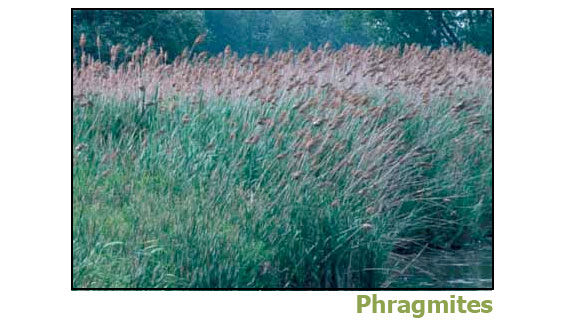

Phragmites
Photo credit: Leslie J. Mehrhoff, University of Connecticut, Bugwood.org
What is it?
A tall wetland grass species
Where's it from?
Regional genetic variations are found in many parts of the world, including the U.S.
How did it get here?
At least one European variety was introduced into the U.S., most likely in the 1800s. It is far more aggressive than the native genetic varieties and has become a serious invader of brackish wetlands in eastern and Midwestern states.
Where is it now?
The invasive Phragmites is abundant along the east coast.
The map below shows data collected by DCR in an aerial survey project spanning 2004 to 2011. Areas surveyed include the Eastern Shore of Virginia, the Rappahannock River and Northern Neck, the York River and Middle Penninsula, North Landing and Northwest Rivers, and Back Bay. Zoom in to your area of interest. Areas of phragmites mapped for this project are shown in purple. You can change the base map by clicking on the box just below the "+" and "-" zoom buttons.
See our StoryMap here >>
What's the harm?
Phragmites overwhelms other marsh plant species from above and below with tall stems that may be 15 feet in height and fast-growing underground stems that form new shoots and a thick tangled root mat. By forming tall dense stands with few other plant species, Phragmites creates a habitat that lacks value to wildlife.
What's being done?
Once established, it is very difficult and expensive to control. In Virginia, state and federal agencies have partnered with The Nature Conservancy, local governments, and private landowners to control Phragmites at priority natural areas.
How can I learn more?
View the DCR Natural Heritage Phragmites management brochure here >>.
 Virginia Invasive Species
Virginia Invasive Species